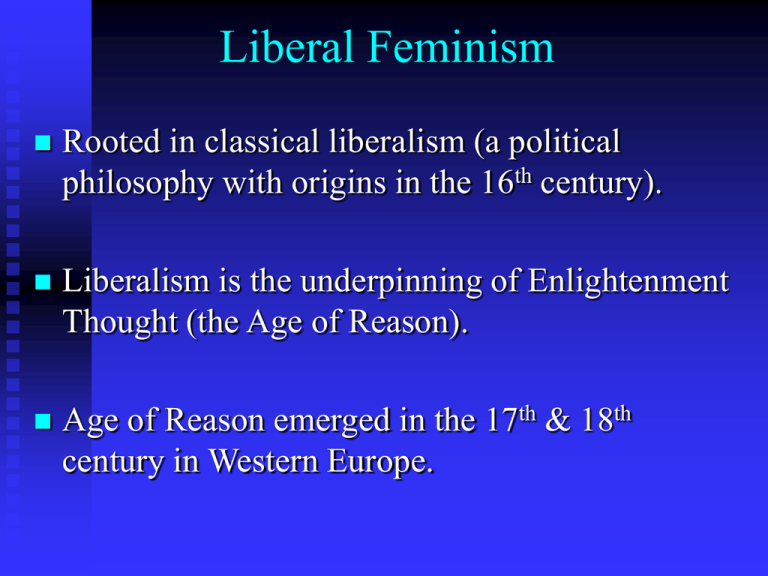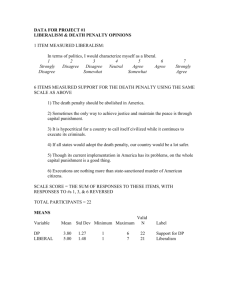Women & Social Reform Liberal Feminism
advertisement

Liberal Feminism Rooted in classical liberalism (a political philosophy with origins in the 16th century). Liberalism is the underpinning of Enlightenment Thought (the Age of Reason). Age of Reason emerged in the 17th & 18th century in Western Europe. Basic Tenets of Liberal Philosophy Individual Rights (including property) Freedom of choice; freedom from confining embraces of other persons or institutions. Critique of religion Values science/reason over religion Commitment to social progress/change Science/reason as a basis for social change Embraces achievement over ascription Social position should be based on merit not birth (critiques idea of biological superiority) Basic tenets cover three key forms of freedom: Economic freedom Political freedom Religious freedom Liberal Approach to Equality Equality of Opportunity Model Freedom to chose education and career. Need a level playing field—everyone should have equal access to opportunities. No legal or social barriers to economic opportunities. Education, hiring, promotions based on achievement. Three Stages of Liberalism 1. Classical Liberalism: Roots in revolt of growing middle classes against mercantilism (government control of commerce & industry). Adam Smith: Free market ideology (no government interference) Revolt against rule by monarchy (French and American Revolutions) 2. Modern Liberalism (20th century): A response to the problems of classical liberalism. Under classical liberalism: Economic power concentrated in the hands of a few. Economic elite exercised control over governments. Large populations of poor; urban crowding; Modern liberalism allowed limited government interference (regulations, social security) in order to protect the liberty of individuals. Government programs to equalize opportunity (civil rights) Examples Can you name an example of a law or policy that allows/ed limited government interference in order to ensure the liberty of individuals? Examples Continued Affirmative Action VAWA Protective legislation (laws that prohibit women from working in dangerous jobs) Labor regulations (wage, hour and safety laws) 3. Neo-liberalism (1990’s) A shift back to classical liberalism— hands off. Limited government regulation Cuts to social safety net Arguments against governments hand in equalizing playing field. Enlightenment thought was rooted in thinking of white propertied men (a reaction of growing merchant class/middle class to nobility) Not extended to women or racial minorities. Liberal Feminism: A Rights Based Movement Focus on equality of opportunity First Wave (1800’s): Suffrage movement Extend rights (voting, property) to women Nineteenth Amendment passed in 1920 Focus also on social reform Second Wave (1960’s) Focus on discrimination in education and employment (Title VII of the Civil Rights Act; Affirmative Action) Focus on reproductive rights Liberal Feminism In line with classical liberalism, liberal feminism sees social positions (gender, class, status) not as biologically determined but as originating through social learning/custom. In sum, a two pronged approach Revise social learning (raise consciousness, encourage women to resist the internalization of social roles, teach girls to take on nontraditional roles) Legal reform: Remove barriers to opportunity Extend rights to women Critique of Liberal Feminism Overlooks race and class inequities. Emphasizes change within existing system No critique/analysis of systemic forms of oppression (oppression is institutionalized and “necessary” to the functioning of capitalist patriarchy) Focus on individual rights overlooks connections between people (collectivist focus) Class Discussion Scenario 1: You are a liberal feminist and have been asked to serve on a committee that is addressing the problem of sex selection. Sex selection is a practice where a woman/couple abort a fetus because the fetus is not the sex that they desire. Because females are often less valued than males, this practice often results in the abortion of female fetuses. Question: What is your position on this practice. Scenario 2: You are a liberal feminist and you have been asked to serve on a committee that is addressing the problem of toxic workplaces. The committee must decide if they should bar women from working in a battery factory that emits toxins. These toxins can cause fetal defects in both pregnant women and women who might become pregnant sometime in the future. These toxins also cause sterility in both men and women. What is your decision?









